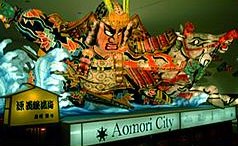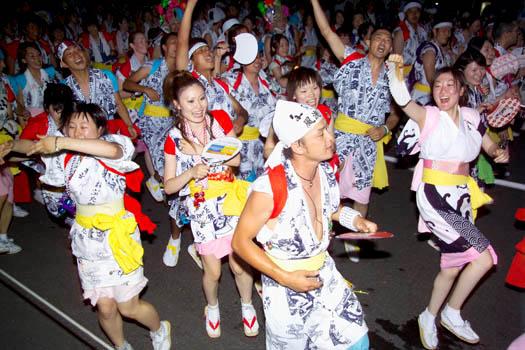AOMORI NEBUTA FESTIVAL
(Nebuta Matsuri)
2 -7 August Annually
While getting to Aomori and back can be a bit of a hassle during Nebuta, it is worth it. I strongly recommend that everyone see this spectacle at least once during their stay here in Misawa.
 The parade begins at 7PM on Sunday, 2 Aug, and lasts about 2 hours. It begins at 1PM on the 7th. I'm not sure about the times during the week. You can call Misawa ITT at 226-3555 and see if they know.
The parade begins at 7PM on Sunday, 2 Aug, and lasts about 2 hours. It begins at 1PM on the 7th. I'm not sure about the times during the week. You can call Misawa ITT at 226-3555 and see if they know.
Probably the best way to get there and back is by train. The parade passes within two or three blocks from the train station. This is the express from Misawa. The Shinkansen from Hachinohe arrives at a station which is not close to the festival route. Just be prepared for some crowded condtions. Driving is not a good option because of the lack of parking near the parade area. However, if you arrive early, you may find parking. Click the link at the bottom of the page for driving instructions. You can check with the Airman and Family Readiness Center at 226-4735 for Misawa ITT at 226-3555 to see if they will have buses going.
 The parade begins at 7PM on Sunday, 2 Aug, and lasts about 2 hours. It begins at 1PM on the 7th. I'm not sure about the times during the week. You can call Misawa ITT at 226-3555 and see if they know.
The parade begins at 7PM on Sunday, 2 Aug, and lasts about 2 hours. It begins at 1PM on the 7th. I'm not sure about the times during the week. You can call Misawa ITT at 226-3555 and see if they know.
Probably the best way to get there and back is by train. The parade passes within two or three blocks from the train station. This is the express from Misawa. The Shinkansen from Hachinohe arrives at a station which is not close to the festival route. Just be prepared for some crowded condtions. Driving is not a good option because of the lack of parking near the parade area. However, if you arrive early, you may find parking. Click the link at the bottom of the page for driving instructions. You can check with the Airman and Family Readiness Center at 226-4735 for Misawa ITT at 226-3555 to see if they will have buses going.
About Nebuta
The most generally accepted theory explaining the origin of the Nebuta Festival tells of the subjugation of rebels in the northern Tohoku area by General Tamuramaro in the early 800's. He had his army create large creatures, called "Nebuta", to frighten the enemy.Another theory is that the Nebuta Festival was developed from the Tanabata festival in China. One of the customs during this festival was float called a Toro. A toro is a wooden frame box wrapped with Japanese paper. The Japanese light a candle inside the Toro and put it out to float onto the river or into the sea. The purpose behind this is to purify themselves and send the evil spirits out to sea. Toro floating is still one of the most impressive and beautiful sights during the summer nights of the Japanese festivals. On the final night, toro floating is accompanied by a large display of colorful fireworks. This is said to be the origin of the Nebuta Festival. Gradually these floats grew in size, as did the festivities, until they are the large size they are now.

Today the Nebuta floats are made of a wood base, carefully covered with this same Japanese paper, beautifully colored, and lighted from the inside with hundreds of light bulbs. In early August the colorful floats are pulled through the streets accompanied by people dancing in native Nebuta costumes, playing tunes on flutes and drums.
Many Aomori citizens are involved in the building of these beautiful floats. The Nebuta designers create their designs, patterned after historical people or themes. Development of themes takes place immediately after the previous year's festivities come to a close. Consequently, it takes the entire year, first in the development, then in the construction of the Nebuta float.
One of the reasons for the popularity of the Nebuta festival is the free participation of many Aomori citizens. The sounds of the Nebuta drums and bamboo flutes inspire people to prepare costumes and begin practice of the Nebuta dances. As the beginning of the parade is signaled, "HANETO"(dancers) join hand-in-hand, and begin their journey through the streets of Aomori. These dancers, colorfully arrayed in Nebuta garb, welcome audience participation. Feel free to join in a circle and enjoy the festivities!
| Festivals Home |